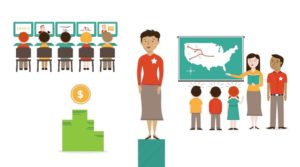This post by Whitaker Brown, an eighth-grade science teacher at Ranson IB Middle School in Charlotte, N.C., first appeared on the Project L.I.F.T. website. See here to learn how to apply in February for Opportunity Culture® positions in the Project L.I.F.T. zone of...
Beverley Tyndall
The Importance of Having an MCL
This post by Nicole Hardy, a kindergarten teacher at Ashley Park Pre-K--8 Elementary School in Charlotte, N.C., first appeared on the Project L.I.F.T. website. See here to learn how to apply in February for Opportunity Culture® positions in the Project L.I.F.T. zone...
New Models Combine Teacher Leadership, Digital Learning
Teachers using blended learning need guidance to help students achieve high-growth learning consistently. Teacher-leaders and their teams need time to collaborate and learn together on the job. Students need access to personalized instruction that catalyzes consistently high growth and expands their thinking.
How can schools achieve all of these goals? Combine blended learning with teacher leadership. Two new models from Public Impact explain how elementary and secondary schools can combine Time-Technology Swaps and Multi-Classroom Leadership— while paying teachers far more, sustainably.
In middle and high schools, students in these models rotate on a fixed schedule between a learning lab and regular classrooms—a “Time-Technology Swap.” In the lab, students learn online, using digital instruction, and offline, pursuing skills practice and project work. This lab time, supervised by paraprofessionals, frees teachers’ time. That time allows teachers, working on teams led by multi-classroom leaders, to teach additional classes, and to plan and collaborate with their teammates on the job. Class time with the teacher is focused primarily on engaging portions of instruction that are best taught in person and in small-group follow-up. Lab work is chosen and directed by the multi-classroom leaders and their team teachers, and is personalized to each student. In some high schools, students do assigned digital learning and project work at home during part of the school day, rather than in a learning lab.
In elementary schools, students similarly engage in personalized digital learning and/or offline skills practice and project work for a limited, age-appropriate portion of the day at school. This frees multi-classroom leaders and team teachers to reach more students without increasing instructional group sizes, and to plan and improve together based on data about student progress each week.
Why should schools combine blended learning and teacher-led teams?
- All students reached with excellence: 100 percent of students can have one or more excellent teachers responsible for their learning in each affected subject, without larger classes.
- On-the-job learning and support for teachers: Teachers can gain and consolidate planning and collaboration time, and teachers can get more support and on-the-job development from multi-classroom leaders.
- Teachers earn more—often much more: Pay increases of up to 67 percent are possible for multi-classroom leaders, while pay for blended-learning teachers on the team can increase up to about 25 percent, within regular budgets, not temporary grants.
Many Opportunity Culture schools are already combining Time Swaps and Multi-Classroom Leadership. These new models offer a glimpse at what they are doing, and provide a starting point for additional schools that want to reach all students with excellent teaching and provide all teachers with career advancement opportunities and on-the-job development and support—creating an Opportunity Culture for all.
Work for Public Impact®!
Public Impact® is hiring--come help us implement an Opportunity Culture® in more schools across the country! Public Impact®, which created the Opportunity Culture® initiative, is a national education policy and management consulting firm based in Chapel Hill, N.C. Our...
Opportunity Culture®: Introduction for Policymakers and Advocates
Policymakers and education advocates can use the Introduction for Policymakers and Advocates slide deck to understand and explain why students and educators need an Opportunity Culture. It provides some background statistics on the history of teaching and pay, and explains how Opportunity Culture career paths are helping address the profession’s challenges today, along with other resources.
Opportunity Culture® Voices: Mixing Team Leadership, Specialization
“ 'One-teacher-one-classroom' is a phrase you hear a lot in education these days: For the past 11 years, that described me. I taught on my own in self-contained third- and fifth-grade classrooms, and I loved my job. But I had enough leadership opportunities, such as...
A Win-Win Model for Students and Teachers
By Danielle Bellar, First Published by Real Clear Education, November 15, 2015
“All students and teachers deserve the opportunity to experience teaching and learning this way.” Multi-Classroom Leader Danielle Bellar and her team had to make schedule and teaching adjustments, but Multi-Classroom Leadership has resulted in higher end-of-grade test scores, a decrease in negative student behavior, and support from parents.
“Every Great Teacher Needs a Coach as Well”
Last week, Multi-Classroom Leader Bobby Miles spoke at the Teach Strong launch, part of a panel moderated by Amanda Ripley, author of the New York Times bestseller The Smartest Kids in the World, and including former Rep. George Miller of California, senior education...
Boosting Idaho Rural Students’ College Prospects by Expanding Access to Great Teaching
In this paper written for the Rural Opportunities Consortium of Idaho, Public Impact examines the challenges that prevent rural schools from providing great teaching, and presents four strategies for increasing access to highly effective instruction in rural Idaho.
Combining Multi-Classroom Leadership and Subject Specialization
Danielle Bellar describes her role as a multi-classroom leader, leading a team of three subject-specializing teachers for 75 5th-graders in Charlotte, N.C. Read Danielle's related blog post, A Win-Win Model for Students and Teachers. Can't access YouTube? Watch...
